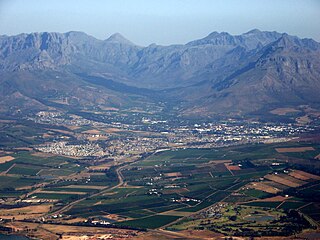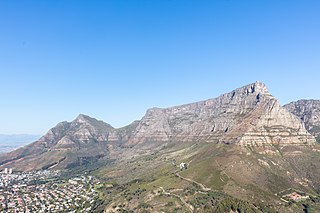
Table Mountain is a flat-topped mountain forming a prominent landmark overlooking the city of Cape Town in South Africa. It is a significant tourist attraction, with many visitors using the cableway or hiking to the top. Table Mountain National Park is the most visited national park in South Africa, attracting 4.2 million people every year for various activities. The mountain has 8,200 plant species, of which around 80% are fynbos, meaning fine bush. It forms part of the Table Mountain National Park, and part of the lands formerly ranged by Khoe-speaking clans, such as the !Uriǁʼaes. It is home to a large array of mostly endemic fauna and flora.

Stellenbosch is a town in the Western Cape province of South Africa, situated about 50 kilometres east of Cape Town, along the banks of the Eerste River at the foot of the Stellenbosch Mountain. The town became known as the City of Oaks or Eikestad in Afrikaans and Dutch due to the large number of oak trees that were planted by its founder, Simon van der Stel, to grace the streets and homesteads.

The Cape Peninsula is a generally rocky peninsula that juts out into the Atlantic Ocean at the south-western extremity of the African continent. At the southern end of the peninsula are Cape Point and the Cape of Good Hope. On the northern end is Table Mountain, overlooking Cape Town, South Africa. The peninsula is 52 km long from Mouille point in the north to Cape Point in the south. The Peninsula has been an island on and off for the past 5 million years, as sea levels fell and rose with the ice age and interglacial global warming cycles of, particularly, the Pleistocene. The last time that the Peninsula was an island was about 1.5 million years ago. Soon afterwards it was joined to the mainland by the emergence from the sea of the sandy area now known as the Cape Flats. The towns and villages of the Cape Peninsula and Cape Flats now form part of the City of Cape Town Metropolitan Municipality.

Somerset West is a town in the Western Cape, South Africa. Organisationally and administratively it is included in the City of Cape Town metropolitan municipality as a suburb of the Helderberg region . The vehicle registration code for Somerset West is CFM and the post code is 7130 for street addresses, and 7129 for post office boxes.

Tankwa Karoo National Park is a national park in South Africa. The park lies about 70 km due west of Sutherland near the border of the Northern Cape and Western Cape, in one of the most arid regions of South Africa, with areas receiving less than 100 mm of average annual precipitation, moisture-bearing clouds from the Atlantic Ocean being largely stopped by the Cederberg mountains. Other low areas receive little more, as the Roodewerf station with 180 mm of mean annual rainfall. In the hottest areas of the park, the mean maximum temperature in January is 38.9 °C, and in July the mean minimum temperature ranges from about 5 to 7 °C. Before this Park's proclamation, the only protected area of Succulent Karoo was the 2 square kilometre patch of the Gamkaberg Nature Reserve. Succulent Karoo has, together with the Cape Floral Kingdom, been declared a Biodiversity Hotspot by Conservation International.

Table Mountain National Park, previously known as the Cape Peninsula National Park, is a national park in Cape Town, South Africa, proclaimed on 29 May 1998, for the purpose of protecting the natural environment of the Table Mountain Chain, and in particular the rare fynbos vegetation. The park is managed by South African National Parks. The property is included as part of the UNESCO Cape Floral Region World Heritage Site.
South African wine has a history dating back to 1659 with the first bottle being produced in Cape Town by its founder and gouverner Jan van Riebeeck. Access to international markets led to new investment in the South African wine market. Production is concentrated around Cape Town, with major vineyard and production centres at Constantia, Paarl, Stellenbosch and Worcester. There are about 60 appellations within the Wine of Origin (WO) system, which was implemented in 1973 with a hierarchy of designated production regions, districts and wards. WO wines must only contain grapes from the specific area of origin. "Single vineyard" wines must come from a defined area of less than 6 hectares. An "Estate Wine" can come from adjacent farms if they are farmed together and wine is produced on site. A ward is an area with a distinctive soil type or climate and is roughly equivalent to a European appellation.

The Cape Floristic Region is a floristic region located near the southern tip of South Africa. It is the only floristic region of the Cape Floristic Kingdom, and includes only one floristic province, known as the Cape Floristic Province.

The Danie Craven Stadium is a rugby union stadium in Stellenbosch, South Africa. Built in 1979, it is part of the Stellenbosch University's sport facilities. The stadium was named after rugby doyen and Springbok scrum half Danie Craven. The stadium holds 16,000 people.

Tulbagh, named after Dutch Cape Colony Governor Ryk Tulbagh, is a town located in the "Land van Waveren" mountain basin, in the Winelands of the Western Cape, South Africa. The basin is fringed on three sides by mountains, and is drained by the Klein Berg River and its tributaries. The nearest towns are Ons Rust and Gouda beyond the Nuwekloof Pass, Wolseley some 15 kilometres (9.3 mi) to the south inside the basin, and Ceres and Prince Alfred Hamlet beyond Michell's Pass in the Warm Bokkeveld.

The Drakenstein mountain named after ex Dutch soldier Hendrik Adriaan van Rheede tot Drakenstein is part of the Cape Fold Belt and are in the Western Cape province of South Africa; they were named in honour of [[Hendrik van Rheede who visited the Cape as Commissioner-General in 1685; Drakenstein was the name of his estate in the Netherlands. They actually comprise two separate ranges, the Klein Drakenstein and Groot Drakenstein Mountains. The former located just to the east of Paarl being punctuated by the Huguenot Tunnel on the N1 highway and Du Toitskloof Pass as the R101 route. The latter is much taller and is located south of Franschhoek and Stellenbosch, with Victoria Peak as its highest point. It is traversed by no mountain passes, but contains the Hottentots-Holland Nature Reserve and also holds title of the wettest place in South Africa in the upper reaches of the Jonkershoek Valley, with over 2,000 millimetres (79 in) of precipitation per annum, the reason for the Wemmershoek dam to be built in this mountain.
Breede River Valley is a region of Western Cape Province, South Africa known for being the largest fruit and wine producing valley in the Western Cape, as well as South Africa's leading race-horse breeding area. It is part of the Boland bordering on becoming Little Karoo towards the east.

Jonkershoek Nature Reserve is a CapeNature nature reserve located approximately 10 km (6 mi) south-east of the town of Stellenbosch in the Western Cape province of South Africa. It covers an area of approximately 11,000 hectares.

Assegaaibosch Nature Reserve is an historic estate and currently a CapeNature nature reserve and World Heritage Site situated in the Jonkershoek Valley near Stellenbosch in the Western Cape province of South Africa. The historic estate was established by Dirk Coetsee, the progenitor of the Coetsee family in South Africa.

Coetzenburg Stadium is a multi-sports venue in Stellenbosch, South Africa, on a portion of the old Coetsenburg Estate which was founded by Dirk Coetsee in 1682 after a grant of land from the Dutch Governor of the Cape Colony Simon van der Stel. The stadium is owned by the Stellenbosch University.

Kumara plicatilis, formerly Aloe plicatilis, the fan-aloe, is a succulent plant endemic to a few mountains in the Fynbos ecoregion, of the Western Cape in South Africa. The plant has an unusual and striking fan-like arrangement of its leaves. It may grow as a large multistemmed shrub or as a small tree. It is one of the two species in the genus Kumara.
The Cape Winelands Biosphere Reserve is located in the Western Cape Province of South Africa approximately 40 km east of Cape Town. The Biosphere Reserve extends from the Kogelberg Biosphere Reserve in the south, northwards along the Cape Fold Belt Mountain Chain and the adjoining valleys constituting the Cape Winelands. The Biosphere Reserve incorporates key portions of the registered Cape Floral Region Protected Areas World Heritage Site. The Reserve was designated in 2007.
Coetsenburg is an historic wine estate and one of the oldest estates in South Africa, established in 1682. It is located at the foot of the Stellenbosch Mountain, which forms part of the estate, in the town of Stellenbosch, 31 miles (50 km) east of Cape Town, in the Cape Winelands of the Western Cape Province. The estate has historically been owned by the Coetsee family and is currently not open to the public. The north-western portion of the original estate is now the Coetsenburg Sports Grounds which belongs to the University of Stellenbosch.
Dirk Coetzee/Coetsee was the Hoofdheemraad (Chancellor) of the District of Stellenbosch and Drakenstein in South Africa for most of the 1690s and early 1700s. He also served as captain of the Stellenbosch Infantry and deacon of the Stellenbosch Moederkerk at different points in time. As captain of the Stellenbosch Infantry, which comprised mostly Huguenots, he provided military backing for a rebellion which began in 1706 against the Governor of the Cape Colony, Willem Adriaan van der Stel, whom the vrijburghers had accused of tyranny, corruption and racketeering. Coetsee was imprisoned in the dungeon of the Castle of Good Hope along with the other leaders of the Huguenots but he was released after a year. The rebellion ultimately succeeded in 1707 when the Dutch East India Company recalled the Governor and other colonial officials. An account of the rebellion is vividly described in the "Diary of Adam Tas".

Val de Vie Estate is a secure, luxury residential and outdoor lifestyle estate occupying 917 hectares situated between Stellenbosch, Paarl and Franschhoek in the Cape Winelands of South Africa.















